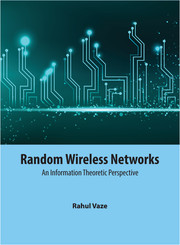Book contents
- Frontmatter
- Dedication
- Contents
- List of Figures
- Preface
- Acknowledgments
- Notation
- 1 Introduction
- 2 Transmission Capacity of ad hoc Networks
- 3 Multiple Antennas
- 4 Two-Way Networks
- 5 Performance Analysis of Cellular Networks
- 6 Delay Normalized Transmission Capacity
- 7 Percolation Theory
- 8 Percolation and Connectivity in Wireless Networks
- 9 Throughput Capacity
- Index
- References
1 - Introduction
Published online by Cambridge University Press: 05 May 2015
- Frontmatter
- Dedication
- Contents
- List of Figures
- Preface
- Acknowledgments
- Notation
- 1 Introduction
- 2 Transmission Capacity of ad hoc Networks
- 3 Multiple Antennas
- 4 Two-Way Networks
- 5 Performance Analysis of Cellular Networks
- 6 Delay Normalized Transmission Capacity
- 7 Percolation Theory
- 8 Percolation and Connectivity in Wireless Networks
- 9 Throughput Capacity
- Index
- References
Summary
Introduction
Wireless networks can be broadly classified into two categories: centralized and de-centralized. A canonical example of a centralized network is a cellular network, where all operations are controlled by basestations, for example, when should each user transmit or receive, thereby avoiding simultaneous transmission (interference) by closely located nodes. Prominent examples of de-centralized or ad hoc networks include sensor or military networks. Sensor network is deployed in a large physical area to either monitor physical parameters, such as temperature, rainfall, and animal census, or intrusion detection. In a military network, a large number of disparate military equipment, e.g., battle tanks, helicopters, ground forces, is connected in a decentralized manner to form a robust and high throughput network. Ad hoc networks are attractive because of their scalability, self-configurability, robustness, etc.
Vehicular network is a more modern example of an ad hoc wireless network, where a large number of sensors are deployed on the highways as well as mounted on vehicles that are used for traffic management, congestion control, and quick accident information exchange. Many other applications of ad hoc wireless networks are also envisaged such as deploying large number of sensors in large building for helping fire fighters in case of fire emergency and in case of earthquakes.
The key feature that distinguishes centralized and ad hoc wireless networks is interference. With centralized control, interference can be avoided in contrast to ad hoc networks, where there is no mechanism of inhibiting multiple transmitters from being active simultaneously. Thus, ad hoc networks give rise to complicated signal interaction at all receiver nodes. As compared to additive noise, interference is structured, and treating interference as noise is known to be sub-optimal. Thus, performance analysis of ad hoc wireless networks is far more complicated than centralized wireless networks.
In this book, we are interested in studying the physical layer issues of ad hoc wireless networks, such as finding the limits on the reliable rate of information transfer and ensuring connectivity among all nodes of the network.
- Type
- Chapter
- Information
- Random Wireless NetworksAn Information Theoretic Perspective, pp. 1 - 11Publisher: Cambridge University PressPrint publication year: 2015



